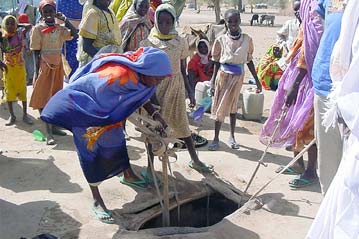UNHCR and partners seek solutions to water woes in Chad
Water is a major challenge to helping some 180,000 Sudanese refugees in eastern Chad. To alleviate these water woes, UNHCR has relied on local knowledge of water sources and geophysical techniques. Recently, it started using remote sensing technology to find hidden sources of water in the desert area.

A typical locally-dug well, which was also used by refugees in Bahai, north-eastern Chad, during the months of May and June 2004, before they were moved to Oure-Cassoni camp. © UNHCR/D.Shrestha
ABECHE, Chad (UNHCR) - Looking at the flooded riverbeds in eastern Chad today, you would never guess that an estimated 180,000 Sudanese refugees have barely enough water to drink in border areas and even in camps established further inland.
Heavy rains began falling in parts of this desert zone as early as May, flooding the usually parched riverbeds, cutting off roads and trapping humanitarian vehicles in mud and rushing water. But despite these dramatic scenes, providing water that is fit to drink for the refugees remains a daunting task. The rain water swelling the seasonal rivers washes away before it can be channelled for storage. It seldom seeps very deep into the ground.
Even if the rain could be collected and treated in an elaborate process called rain harvesting, the feasibility of this depends on the amount and duration of the rainfall for it to be cost effective. The process would also require the availability of appropriate terrain conducive for water collection and storage. The treated water would still have to be transported through the vast desert to the refugees in UNHCR's nine camps.
Currently, UNHCR and its partners truck water into the camps from nearby towns, rely on wells and boreholes dug by partner agencies at the camps, and in one camp treat water from a nearby artificial lake to make it suitable for consumption. The rains have helped somewhat, raising water levels in the lake and boosting the productivity of some of the wells.
But even with all these efforts, the quantity of water yielded has strained to meet the minimum standard of 15 litres per person per day. In some camps, repeated digging and drilling have finally met the minimum requirements, but other camps are still falling short, especially as more refugees continue to arrive in search of aid and shelter.
To help alleviate these water woes, UNHCR has relied on local knowledge of water sources and geophysical techniques such as passing electro-magnetic waves through the ground to determine the physical properties of the underground rock. Recently, the refugee agency took it one step further, using remote sensing technology, including radar satellite images, to find hidden sources of water in the remote desert area.
This is the first time such groundbreaking technology has been used in a humanitarian emergency situation. The pilot project is a joint effort by UNHCR, UNOPS, UNOSAT and French company Radar Technology France (RTF).
Explaining radar satellite's advantages over optical satellite, Jean-Yves Bouchardy, who heads UNHCR's Geographical Information and Mapping Unit, said, "Firstly, it can see through clouds, which is essential in tropical and equatorial areas. Secondly, it can penetrate soil and sand covering, up to 20 metres, to detect potential water sources. Thirdly, it can also detect fault lines, which are crucial in identifying potential reservoirs underground."
Essentially, the project in eastern Chad uses radar and optical satellite images and three-dimensional images taken by the US space shuttle to identify land formations (like fault lines, dykes, seasonal river beds), geological features (granite, sand, basalt rock surfaces), and elevations and sloping to determine water flow.
The combined data is then fed into the Geographical Information System (GIS), a database with a graphic component to map out the data, in order to identify areas with higher potential for groundwater.
UNHCR contributes by providing guidance on how to standardise the resulting maps and information so that partner agencies can understand and implement accordingly. The refugee agency has also sent a water expert to eastern Chad to oversee the "ground truthing" process, where partners on the ground countercheck the survey's findings.
Despite the high-tech approach to identify possible water sources, translating the information into action on the ground in this remote region, often means resorting to simple, low-tech methods. To flag the exact points on the ground where wells should be dug, RTF's engineer resorted to painting stones white as markers and painting hand prints on trees.
The pilot survey was conducted over a 22,500-square-km region around north-eastern Chad's Iriba town. Initial results following a three-week mission to evaluate the survey's accuracy have been encouraging, but as the radar cannot show the quantities of water, UNHCR is currently conducting further tests to pinpoint potential drilling sites.
"Basically, the remote sensing techniques help us to better target where to dig wells," said UNHCR's senior water and sanitation officer, Dinesh Shrestha. "It provides us with one more layer of information to enhance the search for water in such a vast area in a short amount of time."
So far, the images have helped identify possibilities for new wells and boreholes in several existing camps, and work is underway to dig for water at these points.

A flash flood between Farchana to Abéché, but the water often washes away before it can be collected. © UNHCR/D.Shrestha
The survey has also helped identify seven potential sites for new refugee camps and rule out five others due to lack of water potential.
As the groundwater is drawn out for the refugee camps, further measures will be needed to replenish it in the longer term.
UNHCR is exploring the possibility of creating simple barriers at key locations identified by the survey to retain the flow of water long enough to allow some of it to be absorbed into the ground, so that it may be tapped for longer term use by both the local communities and refugees.
